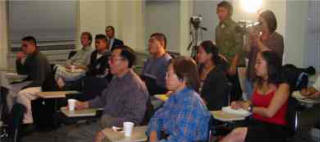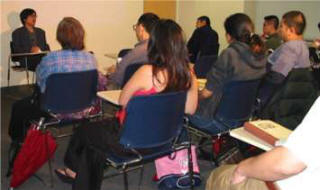
Originally, the main focus of the lecture would be on Asian-American Media in the Last Decade, but after careful reconsideration, it was pushed back to 1987, the year the Asian American International Film Festival celebrated its 10th anniversary. Deemed the Asian American version of Brats, it was a year when many young generation filmmakers and video artists straight out of film school came into public prominence, a succession of both media literate and media conscious individuals.
How do movies shape society? Roddy Bogowa’s black and white “A Small Room In The Big House” filmed with a Super 8 camera, deals with this issue of media consciousness by following the life of a little boy, who has been raised in a projection room of a movie theater where his father works. With his life intimately tied to movies, the little boy’s reactions toward being filmed, such as sticking the microphone in his mouth to mute all sound, is indicative of his self consciousness of the media saturated society around him. The stark black and white images are evocative of a time when personal films reigned supreme in the works of the film-makers. They brought the audience back to a period of pure innocence and joy in the appreciation of the film medium.
In 1987, the number of films being screened at the Asian American International Film Festival was few in numbers, not because Asian Americans weren’t making any films, but because they weren’t part of the traditional Asian American film schools. Over the next two to three years, the number of filmmakers and video artists increased. In 1992, at the 15 th film festival, close to a hundred movies were being screened. A large number of these films were community oriented pieces and documentaries, a distinctive move from the more traditional type of genre.
Asian American media organizations such the National Asian American Telecommunication Association (NATA), Visual Communication (VC), and Asian Cinevision, have all been lumped together by the public, who mistakenly believe that all three are the same. The difference between all three organizations lies in a matter of unequal funding. Also, there is a commonplace misconception that there are plenty of opportunities out there for Asian Americans in Hollywood. The distinction between Asian American media and Asian media needs to be addressed, in order to resolve any lingering confusion. Individuals from Hong Kong such as John Woo, Ronnie Yu and Andy Lau, coming with experience already under their belts, have all gained a foothold in the American movie market. Opportunities for Asian Americans, however, have not been the same.
Questions have been raised about the lack of awareness for Asian identity in movies made in Asia. This is probably an issue more relevant in Asian American movies. For Asians making movies in their own country where they are part of the mainstream, at least ethnically speaking, the Asian identity is generally not their main concern.
The independent Asian American media focuses on the creation of documentaries, which has flourished over the past few years. Arthur Dong, a prominent filmmaker in the genre has created several groundbreaking films, such as Forbidden City U.S.A., and Third World NewsReel. On the other end of the film spectrum, in the commercial industry, individuals such as Wayne Wang and Ang Lee have both seen success in their endeavors. This then becomes problematic, since in order to maintain a profile, one needs to understand the opportunities available to them.

Daryl Chin believed that Ang Lee was able to direct a variety of movies because of his collaboration with many non-Asian professionals who could open doors in Hollywood, whereas Wayne Wang, because of his preference to work by himself, was more limited in directing movies concerning women, as a result of his success in Joy Luck Club.
Ang Lee, who is currently helming The Hulk, started his filmmaking career straight out of film school. He had to wait six years, however, before he got his break by winning a script competition in Taiwan, which led to his first feature film, Pushing Hands. It had a budget of $200,000 and was released on the Chinatown theater circuit around the United States by Central Motion Picture. During the 1990’s, theaters in Chinatown began to close up shop, one after another. After working out a deal with Central Motion Picture for the release rights of his second feature film, The Wedding Banquet, Lee became an international success in both the United States and Asia. Unlike Lee’s success story, many Asian American filmmakers are still having a hard time getting their films made.

With the first generation of Asian American filmmakers, heritage became a topic of interest. The answers, “Why is something Asian American?” is both ambiguous and multifarious. Asian heritage applies to those of Asian descent but were born here in the United States, to those who are Asian and make films here in the U.S., and to those with Asian lineage, by way of mixed marriages.
It is also during this time that many filmmakers dabbled in experimental films. A non-narrative, silent succession of images, Wong Kar Wai’s Chunking Express is a prime example of this, featuring a ten-minute long opening sequence without dialogue. The neon lit backdrop of Hong Kong itself is intensely saturated in pop culture, an extension of its own identity, and those of its people.
Over the last few years, Asian American identity has become less ambiguous and fluid. Through the Asian American International Film Festival, filmmakers with no regular means of exhibiting their films are now able to. Strangely enough, at the Avant-garde Film Festival being held at the Walter Reade Theater, not one Asian American was on the list. What are being featured are American or European Avant-Garde senior citizens. No doubt, the organizers of the festival aren’t looking hard enough for films.
Ending the lecture was a screening of Lana Lin’s Taiwanese Video Club, about a network of women who came to the United States in the 1970s and 80s, who greatly miss the soap operas on television back home. The painterly approach and the detached attitude in the construction of the movie left a deep impression in the audience.
Synopsis by Antony Wong

